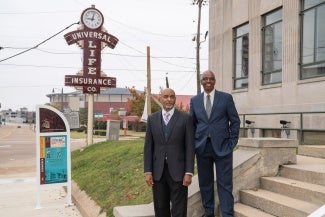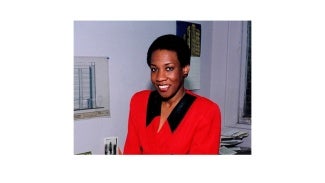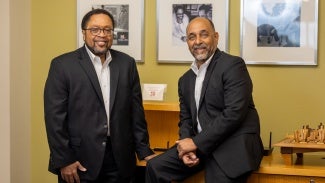
6 Black firm owners share their leadership advice
Leaders from Self+Tucker, Evoke Studio, and more on what has helped them succeed.
To honor and celebrate Black History Month this year, we asked Black firm leaders across the country to share their secrets to success.
“I tell people that I feel blessed every day to be an architect because I so much enjoy what I do, and the impact that we can have as architects,” says Jimmie Tucker, FAIA, managing principal at Self+Tucker Architects. “Everyone can’t say that about the type of work that they do. I just feel fortunate. I’m here in Memphis, which is my hometown, and I have the ability to have a positive impact on the town that I grew up in.” He and his partner Juan Self, AIA, have been running their together firm in Memphis, Tenn., for 30 years, and credit trust as the foundation for their successful partnership.
Read on to hear more from Self, Tucker, and other firm leaders.
Jimmie Tucker, FAIA [pictured above]
Self+Tucker Architects, Memphis, Tenn.
What advice would you give to Black architects who aspire to own their own firm?
Determine a focus and a mission for your firm and strive to create a culture of excellence. Select team members that share your commitment to the goals and aspirations of the firm. Our mission is to design a better Memphis and a better Delta region through responsive design excellence, incorporating sustainability, and engaging the communities that we serve.
Make a difference, make an impact. The platform that we have is immense, and we can really help use our talent to help make a better world.
What has been the most rewarding part of firm ownership for you?
We started our firm in 1995, and we are celebrating our 30-year anniversary in 2025. One of the most rewarding aspects of firm ownership has been to sustain a successful firm that has created opportunities for a multitude of team members over 30 years to grow and contribute as design professionals. And, for Self + Tucker Architects to have created a visible legacy of amazing mission driven projects that have had a positive impact throughout Memphis and the Delta region.
Juan Self, AIA [pictured above]
Self+Tucker Architects, Memphis, Tenn.
What advice would you give to Black architects who aspire to own their own firm?
Make a difference. Architecture is a profoundly powerful platform to positively impact our living environment. While this includes design of the built environment through sustainability and resilience, it extends far beyond this. It extends to community advocacy, engagement, and empowerment for the betterment of the human condition. As a firm owner, you can shape this platform and consequently, shape our world.
What has been the most rewarding part of firm ownership for you?
For me, the rewards of firm ownership are threefold. One, architecture itself is fulfilling. And a firm owner, the impact we've had on the lives of those persons who are our direct teammates and their families—we've been able to mentor them and watch them grow and really mature in the industry. Many of our clients, particularly early on, were upstart businesses themselves. We were able to assist them in helping to develop an economic engine in Memphis and other parts of the Delta region.
It's also the community impact. I call it "empowerment architecture," where through community engagement and assisting residents in really having a voice in what happens in their community, particularly from a development standpoint, and then seeing that blossoming into community activism. Thanks to this project, the community is organized. They have an idea that they can have a voice, whereas prior to that, they may not have really participated very much in those things in their community.
Lastly, it's the meaningful projects that we've done from a historical and cultural standpoint. I'll mention specifically the National Civil Rights Museum, which for me has been more than a thirty-year journey. When I moved to Memphis in 1989, I had an opportunity to work on that project prior to its opening in 1991, and we've done every major project there since. Projects like that have a great national and even international impact.

Roberta Washington
Roberta Washington Architects, New York City
What advice would you give to Black architects who aspire to own their own firm?
I would first congratulate them for being able to do the hardest part first, which is believing in themselves despite living in a society that may not always support them. Secondly, I would ask them to identify architectural firms whose projects and success they admire, while uncovering what they can about that firm’s challenges and how they were overcome. Having a mentor is always a good thing, but the next best thing are sessions at a NOMA or AIA conference related to firm ownership.
What has been the most rewarding part of firm ownership for you?
The most rewarding part of firm ownership is being able to do all those things I used to tell myself I would do if I owned a firm, like trying to match up people with projects and tasks they seemed to enjoy, while teaching and trusting others I hired to flex their own architectural design muscles. Equally rewarding as a firm owner was being able to offer work opportunities to incredibly talented people of all color, gender and age with architectural aspirations, who—before its latest rebirth—were willing to come and work in Harlem.

Edwin Harris, AIA
Evoke Studio, Durham, North Carolina
What advice would you give to Black architects who aspire to own their own firm?
Pursue excellence in every endeavor, no matter its perceived significance. Seek out and learn from those already achieving what you aspire to do. Be bold, persistent, and stubborn enough to ignore doubt and challenges—your dreams are worth it, and your vision has the power to inspire and transform the world around you.
What has been the most rewarding part of firm ownership for you?
Firm ownership has afforded me a meaningful seat at the table to make decisions and create designs that inspire and improve lives for generations. It’s rewarding to serve as an example that others can achieve this too. I stand on the shoulders of those who trailblazed before me and hope to widen the path for future leaders to inspire and improve our world.

Rhodes+Brito Architects, Orlando, Florida
Ruffin Rhodes, AIA, and Max Brito, AIA
Having been in business for nearly 30 years, our advice to aspiring architect firm owners would be to:
Gain experience. First, work at other firms and choose firms that specialize in the types of projects that interest you, and where you will be challenged to learn all aspects of architecture. Keep your ears and eyes open to the nuances of project management, marketing, construction methods, materiality, and team collaboration. Be ambitious, and don’t hesitate to ask questions. Make a concerted effort to understand all the disciplines involved in your projects. While you don’t need to master every discipline, you should be able to coherently explain the system or concept if asked by a client. Experience builds confidence, and keep in mind that architecture takes years to master. Even then, you will continue to learn.
When you’re ready to move forward, make sure you develop a well-defined business plan that includes a marketing strategy and financial plan. You should have a clear understanding of what type of firm you want to develop, what markets to pursue, and the costs of running the office (keeping in mind it will grow every year). You’ll also need capital to fund this venture. That’s a complicated venture on its own. Don’t underestimate the costs. It’s not just the cost to run the company, but also the dollars you’ll need to survive.
Stay diversified. It is better to be in multiple markets than just one, no matter how comfortable it is. Economies go up and down, and so do markets. Find markets that have longevity in your area. It’s also helpful if they have capital budgets from a reliable source.
Market yourself strategically. If you are pursuing projects in the public sector as a new firm, avoid marketing yourself solely as a Minority Business Enterprise (MBE) firm. We know this may be controversial, and we’re not suggesting that you don’t register as an MBE with the appropriate agencies. However, it’s essential to establish yourself and your firm as a credible competitor in the marketplace. We often compete as a Prime Architect for public sector projects, and we are confident that this approach was key to our success. When we team with larger firms for substantial public projects, we bring credentials because of our experiences and success. Always negotiate for a specific scope of the work (labor-only is a trap) and client face time. The fact we are an MBE firm is an added benefit to the team.
What has been the most rewarding part of firm ownership for you?
We still get goosebumps when the community first visits a new or renovated school/community center we designed once it is open to the public. It’s great to see the excitement in their faces as they discover the new facility. The bottom line is we get to impact the community at a scale that mot other professions can only dream of. We help lives in ways most will never understand. That’s the rewarding part of architecture.
AIA would also like to acknowledge the passing of Curtis Moody, FAIA, last October. Moody was the chairman and co-founder of Moody Nolan, America’s largest Black-led architecture firm and winner of AIA’s 2021 Architecture Firm Award. Together with his business partner Howard E. Nolan, he was a pillar of the Black architecture community, eventually growing the firm to more than 350 employees in a dozen offices nationally.
Katherine Flynn is the editor of AIA Architect.
